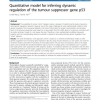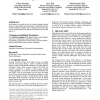146 search results - page 20 / 30 » A Comparison of Bloat Control Methods for Genetic Programmin... |
BMCBI
2010
13 years 7 months ago
2010
Background: The availability of various "omics" datasets creates a prospect of performing the study of genomewide genetic regulatory networks. However, one of the major ...
GECCO
2007
Springer
14 years 1 months ago
2007
Springer
We attack the problem of user fatigue by using an interactive genetic algorithm to evolve user interfaces in the XUL interface definition language. The interactive genetic algori...
BMCBI
2006
13 years 7 months ago
2006
Background: Finding the genetic causes of quantitative traits is a complex and difficult task. Classical methods for mapping quantitative trail loci (QTL) in miceuse an F2 cross b...
GECCO
2007
Springer
14 years 1 months ago
2007
Springer
In this paper, we describe the use of a modern learning classifier system to a data mining task. In particular, in collaboration with a medical specialist, we apply XCS to a prima...
GECCO
2005
Springer
14 years 1 months ago
2005
Springer
We propose a new methodology to look at the fitness contributions (semantics) of different schemata in Genetic Programming (GP). We hypothesize that the significance of a schem...



